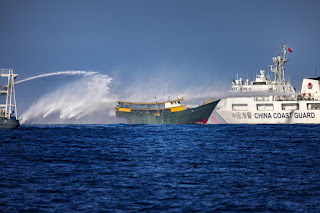Negotiations over a “code
of conduct” (COC) in the South China Sea between the Association of Southeast
Asian Nations (ASEAN) and China waxed and waned for two decades. Last July, in
a bid to expedite an agreement, a three-year deadline was agreed to conclude the talks.
Nothing comes easy in this multifaceted
dispute. Even the title of the agreement to hurry along the talks –
Guidelines for Accelerating the Early Conclusion of an Effective and
Substantive COC – arguably reflects the urgency but also the complexity.
China, Taiwan, and four ASEAN member states –
Brunei, Malaysia, the Philippines, and Vietnam – each have overlapping maritime
claims to the South China Sea. The negotiations for the code, however, involved
all ten ASEAN members with its consensus model and China.
Two major points will likely derail the
objective of accelerating negotiations for a code to manage the South China Sea
disputes peacefully.
The first issue is the state of the talks
themselves, where trust between the parties is plainly lacking. ASEAN negotiators
privately explain that even agreeing on the geographical area the code should
cover – termed the Zone of Applicability – has proven difficult because of the
different parts claimed in the South China Sea. Whereas officials on the
Chinese side believe some ASEAN states are asking for the sky – i.e., demanding
China to give up its sovereignty in the South China Sea. Only then, ASEAN
negotiators see China changing the goalposts during the negotiations.
But not all blame is sheeted to China. Some ASEAN members are
seen as laggards in the negotiations, not fully committed to the process, not
believing they have much at stake in the disputes. One ASEAN negotiator
explained that some ASEAN negotiators turn up ill-prepared, often needing to
consult their capitals for instructions on almost every discussion point,
hampering progress, despite meetings being held five and six times annually.
Wry humour has taken hold, with jokes about another agreement between ASEAN and
China within the next few years to “Accelerate Further the Already Accelerating
Process for the Early Conclusion of an Effective and Substantive COC”.
The second issue concerns the quality of the outcome. There are
doubts whether China will be willing to sign a legally binding agreement, given
that it has already dismissed the outcome of the Permanent Court of
Arbitration’s ruling in 2016 against its claims in the South China
Sea. Should that hurdle be overcome, there are concerns about implementation of
the code. Will there be an effective mechanism to monitor and enforce any
violation?
If not, what does the code amount to? And also, given that ASEAN
operates with a consensus decision-making process, will the deadline push ASEAN
members to water down the substance of the agreement?
Talks on the code of conduct, it must be acknowledged, are only
part of the broader ASEAN engagement with China on the South China Sea. ASEAN’s
efforts with China stretch back years, to 1990 when Indonesia held
the first workshop on the South China Sea involving the different
claimants. In the decades since, there have been efforts to engage
in joint cooperation on extracting resources and protecting the
environment in the disputed waters.
Yet, 34 years on, militarisation has been the dominant theme.
China’s artificial islands bristle with military facilities and long
runways. Beijing has adopted a more aggressive approach to asserting
its claims, lasing, using water cannons, and ramming against other claimants’
boats. Vietnam has expanded its presence and deployed missiles.
The Philippines is seeking to fortify its position.
So setting a deadline for negotiations on a
code of conduct doesn’t necessarily hasten an agreement. Meantime, ASEAN
claimants should continue to build up their capabilities and work with other
external powers, such as Australia and Japan, to defend their maritime
interests. Sometimes, the potential ability to inflict military pain on the
other party may be just the instrument for diplomacy to work well.











0 coment rios: